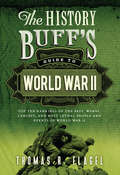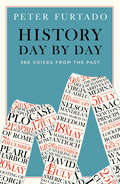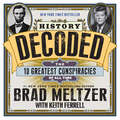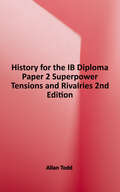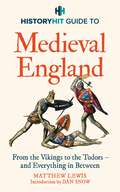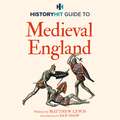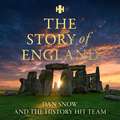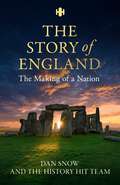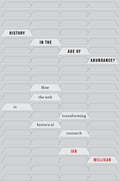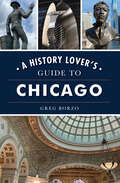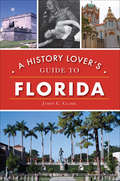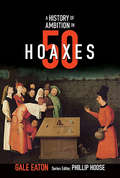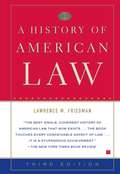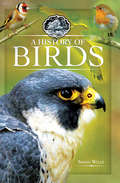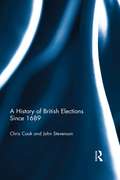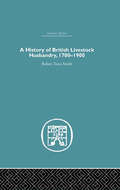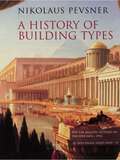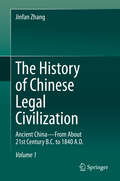- Table View
- List View
The History Buff's Guide to World War II
by Thomas R. FlagelAt a cost of sixty million lives, the largest war in the history of the world devoured cities, gave birth to horrific new weapons, and involved the three worst mass murderers of all time. It also gave rise to some of the finest acts of courage, sacrifice, and lasting change ever to benefit human civilization. World War II stands as the most important event of the modern age, but it is often the most misunderstood. Was it inevitable? Could the Axis have won? Was D-Day the largest invasion ever? Who was the greatest military commander? The worst? Thomas R. Flagel unveils the big picture by using detailed top-ten lists, ranking the best, worst, first, and most significant elements of the largest and deadliest conflict in history. - The Gathering Storm: What caused the war, what made it span the globe and what did people do to try and stop it from coming. - Politics: The most influential speeches, the worst tyrants, and the most important acts of government. - Military Life: The world of unsung soldiers, what they ate, how they lived, and how they died. - The Home Front: Civilians and the hardships they endured, the songs they sang, and the ways they fought back. - In Retrospect: The best commanders, worst mistakes, most decisive battles, and greatest heroines. - Perusing the War: The best avenues for time travel, including historic sites, activities, genealogy, books, and film. - From the rise of Adolf Hitler to the fall of Hiroshima and beyond, The History Buff's Guide to World War II brings a new and compelling perspective to an epoch that fractured the past and formed our world today.
History Day by Day: 366 Voices From The Past
by Peter FurtadoA compelling day-by-day glimpse of highlights from 2,500 years of human history through 366 quotations. History Day by Day presents an original perspective on over two millennia of human history through 366 quotations, one for each day of the year, including leap years. Each quotation, tied to the anniversary of a significant historical event, captures that moment with the immediacy of an eyewitness or the narrative flair of a chronicler. Every day becomes a window to the past: on March 15, 44 BCE, Julius Caesar falls victim to Brutus and his coconspirators; on May 1, 1851, novelist Charlotte Bront visits London’s Great Exhibition; on June 28, 1919, in the Hall of Mirrors at the Palace of Versailles, broken-spirited German delegates sign the treaty that brings World War I to its fateful conclusion; and on September 11, 2001, people across the globe watch in horror as the Twin Towers topple and change the world forever. History Day by Day embraces a wide range of voices, moods, and mediums, from the powerful to the impoverished, the revolutionary to the reactionary, the joyful to the grief-stricken, and the eyewitness to the diarist. Both engrossing anthology and informative overview of world history, History Day by Day offers readers entertainment and information in equal measure.
History Decoded: The 10 Greatest Conspiracies of All Time
by Brad Meltzer Keith FerrellIt's an irresistible combination: Brad Meltzer, a born storyteller, counting down the world's most intriguing unsolved mysteries. And to make this richly illustrated book even richer, each chapter invites the reader along for an interactive experience through the addition of facsimile documents—the evidence! It's a treasure trove for conspiracy buffs, a Griffin and Sabine for history lovers. <P><P>Adapted from Decoded, Meltzer’s hit show on the HISTORY network, History Decoded explores fascinating, unexplained questions. Is Fort Knox empty? Why was Hitler so intent on capturing the Roman “Spear of Destiny”? What’s the government hiding in Area 51? Where did the Confederacy’s $19 million in gold and silver go at the end of the Civil War? And did Lee Harvey Oswald really act alone? <P>Meltzer sifts through the evidence; weighs competing theories; separates what we know to be true with what’s still—and perhaps forever—unproved or unprovable; and in the end, decodes the mystery, arriving at the most likely solution. Along the way we meet Freemasons, Rosicrucians, Nazi propagandists, and the real DB Cooper. <P>At the beginning of each story is a custom-designed envelope—a faux 19th-century leather satchel, a U.S. government classified file—containing facsimiles of relevant evidence: John Wilkes Booth’s alleged unsigned will, a map of the Vatican, Kennedy’s death certificate. The whole is a riveting, interactive adventure through the compelling world of mysteries and conspiracies.
History Education and National Identity in East Asia: History Education And National Identity In East Asia (Reference Books in International Education)
by Edward Vickers Alisa JonesVisions of the past are crucual to the way that any community imagines itself and constructs its identity. This edited volume contains the first significant studies of the politics of history education in East Asian societies.
History for the IB Diploma The Cold War: Superpower Tensions and Rivalries, 2nd Edition (IB Diploma Ser.)
by Allan ToddComprehensive second editions of History for the IB Diploma Paper 2, revised for first teaching in 2015. This coursebook covers Paper 2, World History Topic 12: The Cold War: Superpower Tensions and Rivalries (20th century) of the History for the IB Diploma syllabus for first assessment in 2017. Tailored to the requirements of the IB syllabus and written by experienced IB History examiners and teachers, it offers authoritative and engaging guidance through the following detailed studies of leaders and crises from around the world: Truman, Khrushchev, Gorbachev, Castro, and Reagan; and the Cuban Missile Crisis, the Korean War, the Prague spring, and the Soviet invasion of Afghanistan.
The History Gossip: A Slice of Ye Olde Scandal for Every Day of the Year
by Katie KennedyIn this exclusive book, Katie Kennedy of the hugely popular TikTok account @TheHistoryGossip delivers fascinating, witty, and salacious historical facts for every day of the year, proving that our shared histories are anything but boring. Sexy. Scandalous. Dodgy. If you were of the mind that history is boring, you haven&’t been paying attention. Meet Katie Kennedy, aka The History Gossip. Incorporating British slang and pop culture references and infused with her signature deadpan humor, Katie offers a delightful fusion of Drunk History and Horrible Histories, making learning about the past an absolute riot. From royals embroiled in love triangles to Victorians eating tapeworms for the banter, Katie carefully researches the past and delivers shocking and salacious historical facts for each day of the year. Just as informative as it is funny and entertaining, The History Gossip follows an &“on this day in history&” format with historical events arranged by month and date, and with quirky reference illustrations to help readers visualize the past. This compelling and raunchy read covers topics that range from Mary, Queen of Scots getting the chop (she was beheaded after she was found to be complicit in a plot to murder her cousin, Elizabeth I) to the curse surrounding King Tut&’s tomb (Lord Carnarvon died from an infected mosquito bite two months after visiting). So make yourself a cuppa if you fancy, and get ready to dive into the tales and stories that have made history so very absorbing and a lot outrageous.
HISTORY HIT Guide to Medieval England: From the Vikings to the Tudors – and everything in between
by History HitHave you ever wondered about Edgar Ætheling, the fourteen-year-old who took on William the Conqueror? Or about the woeful collapse of the Angevin Empire under King John? Or what about Eleanor Cobham, a noblewoman found guilty of witchcraft for predicting the death of the King?Join Matthew Lewis and the creators of History Hit on a guided tour spanning more than five centuries of English medieval history and witness spectacular changes in military, political and economic spheres. At home and overseas, England's status and identity was in constant flux, and yet through it all, the nation withstood the turmoil of everything from the 9th century attack of the Great Heathen Army to the year of three kings in 1483 - just.From the bit before 1066 - which matters just as much! - through to the Wars of the Roses, The History Hit Guide to Medieval England charts the extraordinary development of a young nation that went on to emerge as a global superpower.
HISTORY HIT Guide to Medieval England: From the Vikings to the Tudors – and everything in between
by History HitHave you ever wondered about Edgar Ætheling, the fourteen-year-old who took on William the Conqueror? Or about the woeful collapse of the Angevin Empire under King John? Or what about Eleanor Cobham, a noblewoman found guilty of witchcraft for predicting the death of the King?Join Matthew Lewis and the creators of History Hit on a guided tour spanning more than five centuries of English medieval history and witness spectacular changes in military, political and economic spheres. At home and overseas, England's status and identity was in constant flux, and yet through it all, the nation withstood the turmoil of everything from the 9th century attack of the Great Heathen Army to the year of three kings in 1483 - just.From the bit before 1066 - which matters just as much! - through to the Wars of the Roses, The History Hit Guide to Medieval England charts the extraordinary development of a young nation that went on to emerge as a global superpower.
The History Hit Miscellany of Facts, Figures and Fascinating Finds
by History Hit'History is a bottomless reservoir of all the bonkers, heroic, awful and weird things we eccentric humans have ever done. We can't help generating extraordinary stories... Most importantly, like all the best stories, they are true.' - Dan SnowHave you ever wondered who the third man on the moon was? Did you know that Dick Whittington really was the medieval Mayor of London? Why was a pigeon a hero to the American army? What's the difference between a dolmen and a barrow? Who were the Wu, Wei and Shu Han? Was Napoleon really small? Who said 'Pardon me, sir, I didn't mean to' just before they were executed? When was the oldest known shark attack?The answers to all these questions and so much more are contained within this wonderful miscellany of historical facts, figures and fascinating finds which will enthral, entertain and inform everyone who loves history and wants to know more about more.
History Hit Story of England: Making of a Nation
by History Hit SnowA FRESH RETELLING OF ENGLISH HISTORY BY ACCLAIMED HISTORIAN DAN SNOW AND THE HISTORY HIT TEAM: PERFECT FOR FANS OF THE REST IS HISTORY and UNRULY! Praise for History Hit:'Really enjoyable ... highly recommended' ⭐⭐⭐⭐⭐ 'Easy to pick up and hard to put down' ⭐⭐⭐⭐⭐ 'Eye wateringly funny and jaw-droppingly astonishing' ⭐⭐⭐⭐⭐ From battlefields, cathedrals and museums to castles and stately homes, from the Lancastrians and Yorkists to the Roundheads, Royalists and an abundance of kings called Edward (and Henry!), the history of our island nation unravels its rich tapestry beneath our very feet - if only you know where to look.Take, for instance, the Tower of London, which housed a royal menagerie - featuring lions, an African elephant and even a polar bear - some three hundred years before it bore witness to Anne Boleyn's final jest with her executioner. Or the Liverpool Docks, which in the 19th century handled a whopping 9% of global trade. Or, indeed, the atomic weapons base at Orford Ness, which was used to secretly test nuclear weapons during the most heated periods of the Cold War. . . You do not have to travel far for English history to spring into rich and vivid life.In their Story of England, historian Dan Snow and the History Hit team take us on a journey through thousands of years of unceasing drama. It's a tale of invaders and immigrants and visitors and what they brought here. It's a tale of how our ancestors overcame, co-operated and shaped this country to their liking, affecting our landscape, our character, our language, industries, laws, religions and settlements with each passing century. And, ultimately, it's a tale of how England came to be how it is today.
History Hit Story of England: Making of a Nation
by History Hit SnowA FRESH RETELLING OF ENGLISH HISTORY BY ACCLAIMED HISTORIAN DAN SNOW AND THE HISTORY HIT TEAM: PERFECT FOR FANS OF THE REST IS HISTORY and UNRULY! Praise for History Hit:'Really enjoyable . . . highly recommended' ⭐⭐⭐⭐⭐ 'Easy to pick up and hard to put down' ⭐⭐⭐⭐⭐ 'Eye wateringly funny and jaw-droppingly astonishing' ⭐⭐⭐⭐⭐ From battlefields, cathedrals and museums to castles and stately homes, from the Lancastrians and Yorkists to the Roundheads, Royalists and an abundance of kings called Edward (and Henry!), the history of our island nation unravels its rich tapestry beneath our very feet - if only you know where to look.Take, for instance, the Tower of London, which housed a royal menagerie - featuring lions, an African elephant and even a polar bear - some three hundred years before it bore witness to Anne Boleyn's final jest with her executioner. Or the Liverpool Docks, which in the 19th century handled a whopping 9% of global trade. Or, indeed, the atomic weapons base at Orford Ness, which was used to secretly test nuclear weapons during the most heated periods of the Cold War. . . You do not have to travel far for English history to spring into rich and vivid life.In their Story of England, historian Dan Snow and the History Hit team take us on a journey through thousands of years of unceasing drama. It's a tale of invaders and immigrants and visitors and what they brought here. It's a tale of how our ancestors overcame, co-operated and shaped this country to their liking, affecting our landscape, our character, our language, industries, laws, religions and settlements with each passing century. And, ultimately, it's a tale of how England came to be how it is today.
History in the Age of Abundance?: How the Web Is Transforming Historical Research
by Ian MilliganA guide to the World Wide Web and its archives for the contemporary historian.
History Lover's Guide to Chicago, A (History & Guide)
by Greg BorzoFounded next to a great lake and a sluggish river, Chicago grew faster than any city ever has. Splendid department stores created modern retailing, and the skyscraper was invented to handle the needs of booming businesses in an increasingly concentrated downtown. The stockyards fed the world, and railroads turned the city into the nation's transportation hub. A great fire leveled the city, but Chicago rose again. Glorious museums, churches and theaters sprang up. Explore a missile site that became a bird sanctuary and discover how Chicago's first public library came to be located in an abandoned water tank. Follow the steps of business leaders and society dames, anarchists and army generals, and learn whose ashes were surreptitiously sprinkled over Wrigley Field. Combining years of research and countless miles of guided tours, author Greg Borzo pursues Chicago's sweeping historical arc through its fascinating nooks and crannies.
A History Lover's Guide to Florida (History & Guide)
by James C. ClarkExplorers and pirates, hurricanes and shipwrecks, movie stars and presidents—a journey through Florida’s history and a guide to the places it happened.More than any other state (except Nevada), Florida is a state of transplants—where a quarter of the population comes from outside the US, and a third comes from other states. Thanks to its famous beaches and tourist attractions, it’s often thought of as more a destination than a home…even for those who live there. In spite of this—or perhaps because of it—the Sunshine State has one of the richest histories in the nation. Decades before the Pilgrims, the Spanish celebrated Thanksgiving in Florida. Centuries before the first St. Patrick’s Day Parade in New York, the holiday was celebrated in St. Augustine, where urban renewal was underway when Jamestown settlers arrived. In this lively guide, James Clark offers a lifetime of places to explore and facts to fascinate, tracing the state’s long and colorful history from Pensacola to the Florida Keys. You’ll find photos, illustrations, and detailed lists of 10 forts, 10 wars, 5 flags that flew over Florida, 40 historic landmarks, 50 museums, and much more.
A History of Ambition in 50 Hoaxes (History in #50)
by Phillip Hoose Gale EatonWhat do the Trojan Horse, Piltdown Man, Keely Motor Company, and Ponzi Scheme have in common? They were all famous hoaxes, carefully designed and bolstered with false evidence. The con artists in this book pursued a variety of ambitions--making money, winning wars, mocking authority, finding fame, trading an ordinary life for a glamorous one--but they all chose the lowest, fastest road to get there. Every hoax is a curtain, and behind it is a deceiver operating levers and smoke machines to make us see what is not there and miss what is. As P.T. Barnum knew, you can short-circuit critical thinking in any century by telling people what they want to hear. Most scams operate on a personal scale, but some have shaped the balance of world power, inspired explorers to sail uncharted seas, derailed scientific progress, or caused terrible massacres. A HISTORY OF AMBITION IN 50 HOAXES guides us through a rogue's gallery of hustlers, liars, swindlers, imposters, scammers, pretenders, and cheats. In Gale Eaton's wide-ranging synthesis, the history of deception is a colorful tour, with surprising insights behind every curtain.
A History of American Law: Third Edition
by Lawrence M. FriedmanIn this brilliant and immensely readable book, Lawrence M. Friedman tells the whole fascinating story of American law from its beginnings in the colonies to the present day. By showing how close the life of the law is to the economic and political life of the country, he makes a complex subject understandable and engrossing. A History of American Law presents the achievements and failures of the American legal system in the context of America's commercial and working world, family practices, and attitudes toward property, government, crime, and justice. Now completely revised and updated, this groundbreaking work incorporates new material regarding slavery, criminal justice, and twentieth-century law. For laymen and students alike, this remains the only comprehensive authoritative history of American law.
A History of Artificially Intelligent Architecture: Case Studies from the USA, UK, Europe and Japan, 1949–1987 (Routledge Research in Architecture)
by Danyal AhmedA History of Artificially Intelligent Architecture: Case Studies from the USA, UK, Europe and Japan, 1949-1987 provides a comprehensive survey of architectural projects exhibiting intelligence since the Late First Century right up to the present day. Tracing the social, scientific and technological developments, this book analyses case studies from both conceived and executed architectural projects by Architects and Cyberneticians from the United States, United Kingdom, Europe and Japan from 1949-87. From the Late First Century through to the Seventeenth Century, the scientific endeavors of the Hero of Alexandria, Ramon Llull, Paracelsus, René Descartes, Jacques de Vaucanson, Pierre Jacquet-Droz, and Charles Babbage have been presented in which they attempted to review, analyse and conclude the notion of artificial intelligence. Coming to the Twenty-First Century and witnessing a period, particularly from 1949-87, where nothing had been constant, Architects and Cyberneticians whose architectural projects attempted to simulate intelligence include Cedric Price, Richard Saul Wurman, Nicholas Negroponte, Kenzo Tange, Arata Isozaki, Charles Eames, Ezra D. Ehrenkrantz, Richard Rogers, Renzo Piano, and Gordon Pask respectively. This book asks: How have Polymaths, Architects and Cyberneticians simulated artificial intelligence in their scientific/architectural projects? Is it possible to define intelligence purely based on the history of architecture? Or, on a more extensive level, is it possible to view artificial intelligence originating from the history of architecture instead of computational paradigm? The transdisciplinarity of the book makes it of interest to researchers and students of technologically advanced architecture’s history, theory, and criticism, artificial intelligence, cybernetics, information and communications, urban and sustainable design, ergonomics, computer applications, and digital design and fabrication.
A History of Birds
by Simon Wills“Intriguing stories from the history of the human relationship with birds, including their symbolism in art, literature, religion, and folklore” (Booklist). Even the most well-informed wildlife enthusiast will be entertained by the stories and fascinating facts in this beautifully illustrated book. Our ancestors hunted, tamed, worshipped, and depicted birds, and even bestowed magical properties upon them. Why did ancient writers consider the sparrow a lustful creature? Which bird was killed and hung up to predict the weather? And what was an “arse-foot?” Wildlife photographer and history journalist Simon Wills explores the intriguing and at times bizarre stories behind our relationship with birds. Find out why robins feature on Christmas cards, and how Mozart was persuaded to keep a pet starling. What bird did Florence Nightingale carry around in her pocket? How did the blue tit get its name? Whole careers have been created around birds—from falconers to ostrich farmers—and birds have had great symbolic importance too. Discover, for example, why Raleigh bicycles carry a heron logo and why church lecterns are in the shape of an eagle. If you enjoy wildlife, then this book is full of surprises. Pigeons were trained to carry messages in wartime, but could gulls be taught to hunt U-boats? And which American president’s parrot started swearing at his funeral? “A pleasing and often illuminating book with many examples of historical connections with birds, from Queen Victoria’s parrots and the Prince of Wales’s feathers to Kellogg’s cockerel and recipes for flamingos.” —Bird Watch
A History of British Elections since 1689
by Chris Cook John StevensonA History of British Elections since 1689 represents a unique single-volume authoritative reference guide to British elections and electoral systems from the Glorious Revolution to the present day. The main focus is on general elections and associated by-elections, but Chris Cook and John Stevenson also cover national referenda, European parliament elections, municipal elections, and elections to the Welsh and Northern Irish assemblies and the Scottish parliament. The outcome and political significance of all these elections are looked at in detail, but the authors also discuss broader themes and debates in British electoral history, for example: the evolution of the electoral system, parliamentary reform, women's suffrage, constituency size and numbers, elimination of corrupt practices, and other important topics. The book also follows the fortunes not only of the major political parties but of fringe movements of the extreme right and left. Combining data, summary and analysis with thematic overviews and chronological outlines, this major new reference provides a definitive guide to the long and varied history of British elections and is essential reading for students of British political history.
A History of British Livestock Husbandry, 1700-1900
by Robert Trow-SmithFirst Published in 2005. Routledge is an imprint of Taylor & Francis, an informa company.
A History of British Livestock Husbandry, to 1700
by Robert Trow-SmithFirst Published in 2005. Routledge is an imprint of Taylor & Francis, an informa company.
A History of Building Types (The A. W. Mellon Lectures in the Fine Arts #19)
by Nikolaus PevsnerAn essential guide to vital and often overlooked features of the architectural and social inheritance of the WestThis book provides vital insights into the ways in which architecture reflects the character of society. Drawing on his immense erudition and keenly discerning eye, Nikolaus Pevsner describes twenty types of buildings ranging from the most monumental to the least, and from the ideal to the most utilitarian. He covers both European and American architecture, with examples chosen largely from the nineteenth century, the crucial period for diversification. Included are national monuments, libraries, theaters, hospitals, prisons, factories, hotels, and many other public buildings. Incisive and authoritative, A History of Building Types traces the evolution of each type in response to social and architectural change, and discusses differing attitudes toward function, materials, and style.Please note: All images in this ebook are presented in black and white and have been reduced.
A History of Capital Punishment in the Australian Colonies, 1788 to 1900 (Palgrave Histories of Policing, Punishment and Justice)
by Steven AndersonThis book provides a comprehensive overview of capital punishment in the Australian colonies for the very first time. The author illuminates all aspects of the penalty, from shortcomings in execution technique, to the behaviour of the dying criminal, and the antics of the scaffold crowd. Mercy rates, execution numbers, and capital crimes are explored alongside the transition from public to private executions and the push to abolish the death penalty completely. Notions of culture and communication freely pollinate within a conceptual framework of penal change that explains the many transformations the death penalty underwent. A vast array of sources are assembled into one compelling argument that shows how the ‘lesson’ of the gallows was to be safeguarded, refined, and improved at all costs. This concise and engaging work will be a lasting resource for students, scholars, and general readers who want an in-depth understanding of a long feared punishment.Dr. Steven Anderson is a Visiting Research Fellow in the History Department at The University of Adelaide, Australia. His academic research explores the role of capital punishment in the Australian colonies by situating developments in these jurisdictions within global contexts and conceptual debates.
A History of China
by Wolfram EberhardFirst published in 1950. This re-issues the fourth edition of 1977. This is a social history of China, presenting the main lines of development of the Chinese social structure from the earliest times to the present day. The book discusses the origins of the present regime and developments in China in the last years, and political, social and cultural changes are all analyzed. The text is based upon the study of original Chinese sources and also the work of Chinese, Japanese and Western scholars.
The History of Chinese Legal Civilization: Ancient China—From About 21st Century B.C. to 1840 A.D.
by Jinfan ZhangThis book, based on the theory of Marxism-Leninism, aims to study the essence, content and features of various legal systems in China in different historical periods, as well as the rules of the development of Chinese legal system. It effectively combines classic and historical analysis to probe the historical facts and elaborate the historical role of the legal system, revealing both the general and the specific rules of the development of the Chinese legal system on the basis of the existing relevant researches. The subject matter is of abundant theoretical and practical significance, as it enriches Marxist legal studies, deepens the readers’ understanding of Chinese legal civilization and offers guiding principles for the creation of socialist legal systems with Chinese characteristics. The chapters are structured chronologically, ranging from the Xia and Shang Dynasties, the Western Zhou Dynasty, the Spring and Autumn Period, the Han Dynasty, the South and North Dynasties, the Sui and Tang Dynasties, the Song Dynasty to the Ming and Qing Dynasties when Chinese legal system took on its final form. The chapters are compiled according to legislation, administrative law, criminal law and judicial system. Besides, the Chinese legal civilization after the Revolution of 1911 led by Sun Yat-sen is also addressed.
